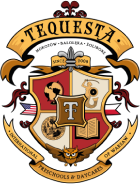For adults, table manners are second nature. For a child, they’re a whole new world of rules, gestures, and rituals. Learning how to eat at the table is more than just mastering cutlery. It’s about attentiveness, respect for others, and enjoying shared moments. At Tequesta, we know that teaching table manners isn’t about “formal upbringing” but about everyday baby steps children are eager to take when they feel encouraged and supported.
Mealtime as a daily ritual
Shared meals are moments of pause. For children, they’re a chance not only to satisfy hunger but to spend time with others, talk, and feel part of a group. That’s why at Tequesta, each meal begins with a simple ritual – helping set the table, greeting one another, and giving thanks. This builds a sense of calm and teaches children that meals are worth celebrating.
Children sit together in a familiar and orderly setting. They know to wash their hands, wait for everyone to be ready, and then begin eating. Repetition helps turn these actions into habits – not obligations.
Introducing rules – without pressure or punishment
For young children, rules must be clear and age-appropriate. We don’t expect a three-year-old to skillfully use a knife and fork – but we do celebrate when they reach for a napkin on their own or wait patiently for their turn.
When introducing table manners, we focus on a few key behaviors:
- washing hands before eating,
- sitting in their designated spot,
- eating calmly with mouths closed,
- using “please” and “thank you,”
- tidying up afterward.
At Tequesta, we use positive reinforcement. A child who remembers to say “thank you” or waits for others to be served is praised or met with a warm smile. This builds the sense that good manners are something enjoyable – both for them and for those around them.
Manners as a path to empathy
Table manners are not just about rules but about learning to be considerate. A preschooler who sees someone drop a spoon and helps pick it up is taking their first steps toward empathy. These moments spark great conversations: “Look how you helped Anthony – that made him happy,” or “How would you feel if no one waited for you to be served?”
Through these small moments, children learn that manners aren’t about “what’s proper,” but about “how to make others feel good.”
Family meals at home – continuing the preschool rhythm
To reinforce what children learn at preschool, it’s worth creating similar routines at home. Sitting down for one meal together each day – without rush or distractions – makes a big difference. Children love being involved, so giving them a small task like setting the table or handing out napkins makes them feel responsible.
Perfection isn’t the goal – sometimes juice will spill, or a fork will fall. What matters is that the child feels like an active part of the mealtime experience, and that their contributions are meaningful.
Manners grow with your child
It starts with small things: “please,” “thank you,” clean hands. Over time, it grows: using cutlery properly, helping clean up, speaking politely. Table manners evolve with the child – and they don’t require strict training, just the presence of an adult who leads by example and creates a supportive space.
At Tequesta, we believe that good manners at the table aren’t a luxury or a chore. They’re an everyday opportunity to show children that relationships – even those around the table – thrive on attentiveness, respect, and the joy of being together. Because good manners start with tiny spoons and big hearts.


